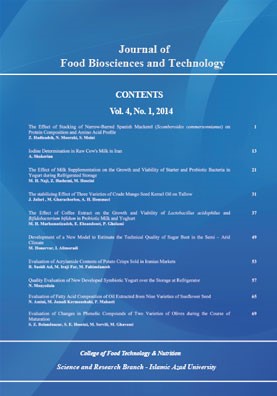The Effect of Milk Supplementation on the Growth and Viability of Starter and Probiotic Bacteria in Yogurt during Refrigerated Storage
Subject Areas : food microbiologyM. H. Naji 1 , Z Hashemi 2 , M Hoseini 3
1 - Ph. D. Student of Food Science and Technology, Academic Member of Zarindashat Branch, Islamic Azad University, Fars, Iran.
2 - Shiraz Medical Science University, Fars, Iran.
3 - Ph. D. Student of Food Science and Technology, College of Agriculture, Mashhad University, Khorasane Razavi, Iran.
Keywords:
Abstract :
AOAC. (1984) Association of Official Analytical Chemists.14th ed. Washington, DC.
Chick, H., Shin, H. S. & Ustunol, Z. (2001). Growth and acid production by lactic acid bacteria and Bifidobacteria growth in skin milk containing honey. Journal of Food Science, 66, 478 – 481.
Dave, R. I. & Shah, N. P. (1997a). Viability of yoghurt and probiotic bacteria in yoghurts made from commercial starter cultures. International Dairy Journal, 7, 31 – 41.
Dave, R. I. & Shah, N. P. (1997b). Effect of cysteine on the viability of yoghurt and probiotic bacteria in yoghurts made with commercial starter cultures. International Dairy Journal, 7, 537 – 545.
Dave, R. I. & Shah, N. P. (1998). Ingredient supplementation effects on viability of probiotic bacteria in yogurt. Journal of Dairy Science, 81, 2804 – 2816.
De Vuyst, L. (2000). Technology aspects related to the application of functional starter culture. Food Technology and
Biotechnology, 38, 105 – 112.
Donkor, O. N., Henriksson, A., Vasiljevic, T. & Shah, N. P. (2006). Effect of acidification on the activity of probiotics in yogurt during cold storage. International Dairy Journal. 16, 1181 – 1189.
Favaro-Tindade, C. S. & Grosso, C.R.F. (2004). Stability of free and immobilized Lactobacillus acidophilus and Bifidobacterium lactis in acidified milk and immobilized B. lactis in yoghurt. Brazilian Journal of Microbiology. 35, 151-156.
Gilliland, S. E. & Speck, M. L. (1977). Instability of lactobacillus acidophilus in yogurt. Journal of Dairy Science, 60, 1394 – 1398.
Gilliland, S. E., Reilly, S. S. & Kim, G. B. (2002). Viability during storage of selected probiotic Lactobacilli and Bifidobacteria in yogurt –like product. Journal of Food Science, 67, 3091 – 3095.
Gomes, A. M. P. & Malcata, F. X. (1991). Bifidobacteria spp. and lactobacillus acidophilus: biological, biochemical, technological and therapeutical properties relevant for use as probiotic. Trends in Food Science & Technology, 10, 139 – 157.
ISO/DIS 20128 IDF 192 (2005). Fermented milk-Enumeration of lactobacillus acidophilus-Colony-count technique at 37°C, International Organization for Standardization and International Dairy Federation.
Lourens-Hattingh, A. & Viljoen, B. C. (2001). Yogurt as probiotic carrier food. International Dairy Journal, 11, 1 – 17.
Nighswonger, B. D., Brashears, M. M. & Gilliland, S. E. (1996). Viability of lactobacillus acidophilus and lactobacillus casein in fermented milk products during refrigerated storage. Journal of Dairy Science, 79, 212 – 219.
Oliviera, M. N., Sodini, I., Remeuf, F. & Corrieu, G. (2001). Effect of milk supplementation and culture composition on acidification, textural properties and microbiological stability of fermented milk containing probiotic bacteria. International Dairy Journal, 11, 935 – 942.
Petschow, B. W. & Talbott, R. D. (1990). Growth promotion of Bifidobacterium species by whey and casein fractions from human and bovine milk. Journal of Clinical Microbiology, 28, 287 – 292.
Prado, F. C., Parada, J. L., Pandey, A. & Soccol, C. R. (2008). Trends in non-dairy probiotic beverages. Food Research International, 41, 111 – 123.
Saarela, M., Mogensen, G., Fonden, R., Mättö, J. & Mattila-Sandholm, T. (2000). Probiotic bacteria: safety, functional and technological properties. Journal of Biotechnology, 84, 197 – 215.
Samona, A. & Robinson, R. K. (1994). Effect of yogurt cultures on the survival of bifidobacteria in fermented milks. Journal of The Society of Dairy Technology, 47(2), 58-60
Shah, N. P., Lankaputhra, W. E. V., Britz, M. L. & Kyle, W. S. A. (1995). Survival of lactobacillus acidophilus and Bifidobacterium bifidum in commercial yoghurt during refrigerated storage. International Dairy Journal, 5, 515 – 521.
Shah, N. P. & Lankaputhra, W. E. V. (1997). Improving viability of lactobacillus acidophilus and Bifidobacterium spp. in yogurt. International Dairy Journal, 7, 349 – 356.
Sodini, I., Lucas, A., Oliviera, M. N.,
Remeuf, F. & Corrieu, G. (2002). Effect of milk base and starter culture on acidification, texture, and probiotic cell counts in fermented milk processing. Journal of Dairy Science, 85, 2479 – 2488.
Talwalkar, A. & Kailasapathy, K. (2002). A review of oxygen toxicity in probiotic yogurts: influence on the survival of probiotic bacteria and protective techniques. Comprehensive Review in Food Science and Food Safety, 3, 117 – 124.
Tamime, A. Y. & Robinson, R. K. (2000). Yogurt: Science and Technology, Cambridge, UK: CRC Press.
Tamime, A. Y., Saarela, M., Korslund Sondergaard, A., Mistry, V. V. & Shah, N. P. (2005). Production and maintenance of viability of probiotic micro-organisms in dairy products. In A.Y. Tamime (Eds), Probiotic dairy products, (pp. 39 – 72). AYr, UK: (Blackwell publishing.
Vinderola, C. G., Bailo, N. & Reinheimer, J. A. (2000). Survival of probiotic microflora in Argentinain yoghurts during refrigerated storage. Food Research International, 33, 97 – 102.
Wang, Y. C., Yu, R. C. & Chou, C. C. (2002). Growth and survival of Bifidobacteria and lactic acid bacteria during the fermentation and storage of cultured soymilk drinks. Food Microbiology, 19, 501 – 508.


